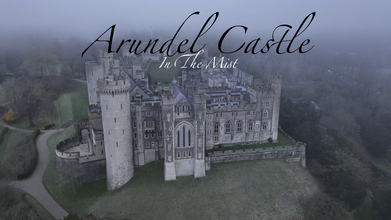
Interested In This Footage?
DJI Mavic 3 PRO 5.1k Presents: Arundel Castle's Icy Charm in the Mist
AIRVŪZ STAFF NOTE :
SouthCoastDronesUK brings us this excellent drone video of Arundel Castle, one of the great cultural landmarks of South England. Located in its namesake town in West Sussex, the castle was established by a lieutenants of William the Conqueror following the Norman invasion of England in 1066. Considered one of the great Norman castles, it's the seat of the Dukes of Norfolk. Arundel Castle was used as a filming location for the 1994 movie The Madness of King George, and more recently for a scene in the 2017 blockbuster Wonder Woman.
- almost 2 years ago
- 1.5k VŪZ
11 


- 14
- Report
Arundel castle on a very cold winters morning at -4 degrees in the mist. Unfortunately it was a short flight due to extreme icing on the props so i had to call it a day i was hoping for the sun to break through the mist but it was just far too thick. Arundel Castle is a restored and remodelled medieval castle in Arundel, West Sussex, England. It was established by Roger de Montgomery in the 11th century. The castle was damaged in the English Civil War and then restored in the 18th and 19th centuries by Charles Howard, 11th Duke of Norfolk.[2] Since the 11th century, the castle has been the seat of the Earls of Arundel and the Dukes of Norfolk. It is a Grade I listed building.[1] History Arundel Castle and town in 1644 Junction of the old and new walls View of Arundel Castle's Norman motte with the quadrangle in the foreground. Courtyard The original structure was a motte-and-bailey castle. Roger de Montgomery was declared the first Earl of Arundel as the King granted him the property as part of a much larger package of hundreds of manors.[3] Roger, who was a cousin of William the Conqueror, had stayed in Normandy to keep the peace there while William was away in England. He was rewarded for his loyalty with extensive lands in the Welsh Marches and across the country, together with one fifth of Sussex (Arundel Rape). He began work on Arundel Castle in around 1067.[4] Between 1101 and 1102 the castle was besieged by the forces of Henry I after its holder Robert of Bellême rebelled.[5] The siege ended with the castle surrendering to the king.[5] The castle then passed to Adeliza of Louvain (who had previously been married to Henry I) and her husband William d'Aubigny. Empress Matilda stayed in the castle, in 1139.[4] It then passed down the d'Aubigny line until the death of Hugh d'Aubigny, 5th Earl of Arundel in 1243.[4] John Fitzalan then inherited jure matris the castle and honour of Arundel, by which, according to Henry VI's "admission" of 1433, he was later retrospectively held to have become de jure Earl of Arundel.[6] The FitzAlan male line ceased on the death of Henry Fitzalan, 12th Earl of Arundel, whose daughter and heiress Mary FitzAlan married Thomas Howard, 4th Duke of Norfolk in 1555, to whose descendants the castle and earldom passed.[7] In 1643, during the First English Civil War, the castle was besieged.[8] The 800 royalists inside surrendered after 18 days. Afterwards in 1653 Parliament ordered the slighting of the castle; however "weather probably destroyed more".[9] Although the castle remained in the hands of the Howard family over the succeeding centuries, it was not their favourite residence, and the various Dukes of Norfolk invested their time and energy into improving other ducal estates, including Norfolk House in London.[10] Charles Howard, 11th Duke of Norfolk, was known for his restoration work and improvements to the castle beginning in 1787.[4] The folly that still stands on the hill above Swanbourne Lake was commissioned by and built for the Duke by Francis Hiorne at this time.[11] In 1846, Queen Victoria and her husband, Prince Albert, visited Arundel Castle for three days. Henry Howard, 13th Duke of Norfolk, internally remodelled the castle in time for her visit. The architectural firm responsible for design of the furniture was named Morant. The work included a suite of six rooms, built on the second floor of the south-east range at this time.[4] The 19th-century embellishments had not been completed when this picture was published in 1880. After the 1846 Royal visit the 15th Duke began re-structuring the castle again from 1875 to 1905. The work, which was done to the designs of Charles Alban Buckler and undertaken by Rattee and Kett of Cambridge, was completed in the late 19th century.[12][13] The 16th Duke had planned to give the castle to the National Trust but following his death in 1975 the 17th Duke cancelled the plan. He created an independent charitable trust to guarantee the castle's future, and oversaw restorative works.[14] The extensive gardens had received significant improvements by early 2020 through the efforts of head gardener Martin Duncan and his crew. A horticulturalist and landscape designer, Duncan has been working at the Castle since 2009; in 2018, he received the Kew Guild Medal. The gardeners and volunteers "have worked wonders with their bold and innovative plantings", according to an April 2020 report by Country Life. Their most recent efforts led to a wild water garden around the ponds. https://en.wikipedia.org/wiki/Arundel... #dji #castle #winter #misty #ice
Up Next
Arundel Castle arising from the mist - Dji Mavic Pro - Skydronauts.uk

- SKYDRONAUTS
- 502 VŪZ
5 - 3
- over 8 years ago
Stonehenge at Sunrise on a Misty Sunday Morning - Shot on a DJI Mavic 3 PRO 5.1k 50fps

- SouthCoastDronesUK
- 2.0k VŪZ
10 - 16
- almost 2 years ago
Our Adventure to Wales - A View of Wales From The Sky -DJI Mavic 3 PRO & DJI Mini 3 PRO

- SouthCoastDronesUK
- 1.7k VŪZ
9 - 12
- almost 2 years ago
Portsmouth Night View

- SouthCoastDronesUK
- 1.0k VŪZ
0 - 0
- over 1 year ago
The Most Captivating Drone Shots of 2023: DJI Mavic 3 PRO & DJI Mini 3 PRO

- SouthCoastDronesUK
- 1.5k VŪZ
10 - 15
- almost 2 years ago
What's Your Serenity Film | Drone Film | Mavic Pro 3

- benhawkinslive
- 2.5k VŪZ
6 - 8
- almost 4 years ago
Portchester Castle at Sunrise by DJI Mavic 3 PRO

- SouthCoastDronesUK
- 618 VŪZ
7 - 9
- almost 2 years ago
HMS Montrose F236 - HMS Monmouth F235 - Hardway Gosport - Waiting to be scrapped.

- SouthCoastDronesUK
- 664 VŪZ
8 - 9
- almost 2 years ago
Glastonbury Tor, UK

- John_W13
- 852 VŪZ
5 - 2
- over 2 years ago
Silent Beauty: Kinderdijk Windmills in the Early Morning Fog

- By_ewold
- 1.1k VŪZ
9 - 12
- 4 months ago
